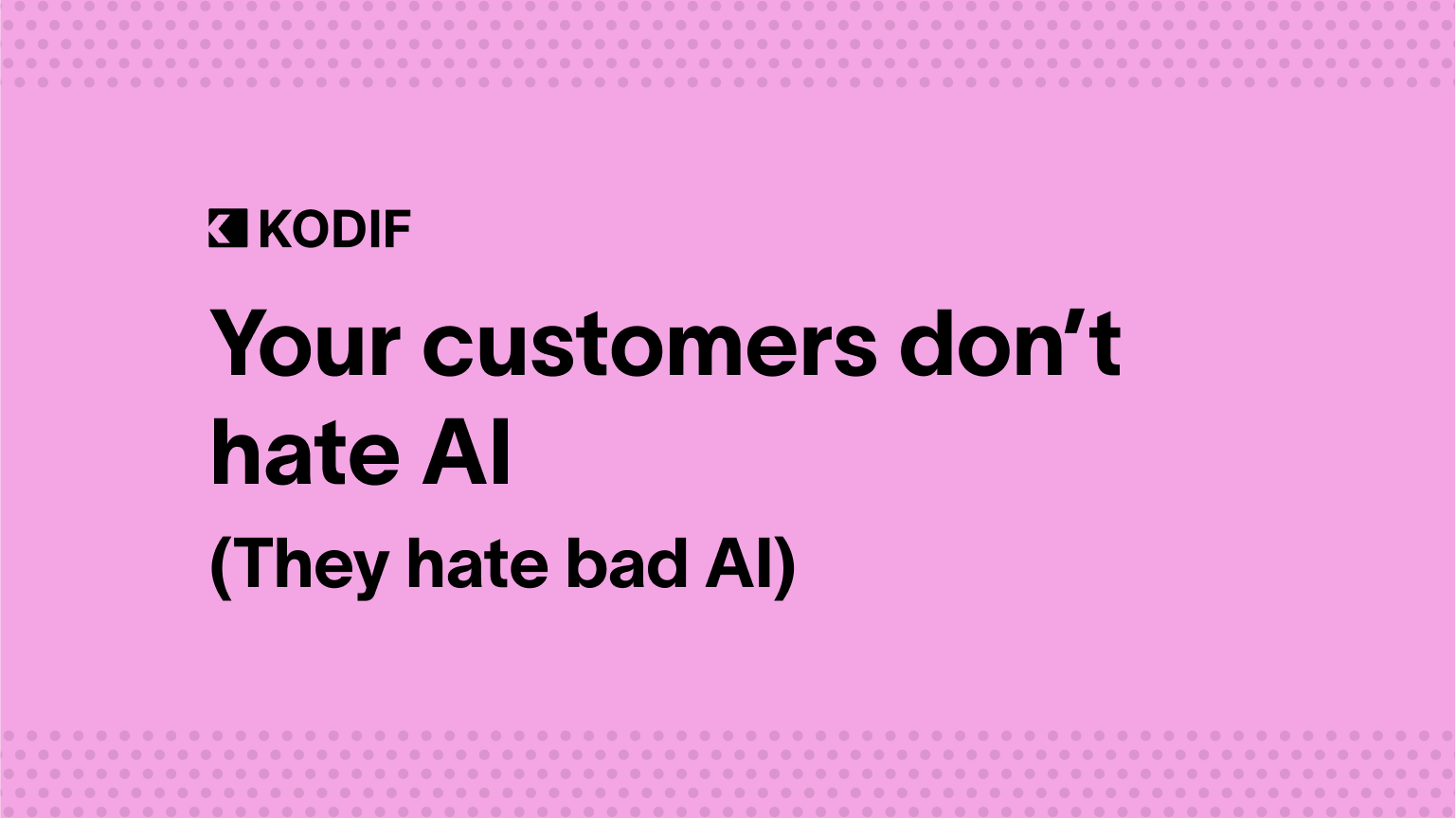“Customers hate talking to AI.”
Do they, though?
Or do they hate talking to bad AI—the kind that misunderstands simple questions, loops them into oblivion, or offers responses so generic they feel like they came from a Magic 8 Ball?
Good AI is like the awesome waiter at your favorite restaurant. Anticipates your needs, speaks your language, knows when to step in and when to step out of the way.
So no, customers don’t hate AI. They hate feeling like they’re talking to Clippy’s evil twin.
Let’s unpack why AI sometimes gets a bad rap, how to make sure yours doesn’t, and what great support teams are doing to get the most out of AI’s full potential—without making customers want to throw their phone into the ocean.
What bad AI looks (and feels) like
Customers know bad AI when they see it—and unfortunately, they see it a lot. Here’s how it shows up:
It doesn’t understand what you’re saying
Even mildly nuanced questions confuse it. Instead of clarifying, it repeats itself or gives the same useless answer in a loop. Think:
User: “Can I get a refund on a canceled flight?”
Bot: “Did you mean cancel a flight?”
It fakes competence
Some bots give the illusion of help—offering canned answers to complex issues without taking meaningful action. That’s not helpful, it’s infuriating.
It’s a one-way street
The worst AI offenders don’t allow a graceful escape to a human agent when it’s needed. They trap the customer in a self-service loop, hoping they’ll give up before the SLA clock runs out.
None of these flaws are inherent to AI itself. They’re design and deployment issues. Poor training, lack of real-world data, and no fallback plan—that’s what breaks the CX.
What good AI actually does
Now let’s look at the flip side: how AI can provide great customer service when it’s thoughtfully deployed.
Understands natural language in context
It doesn’t just keyword-match—it grasps intent.
Whether a customer types “My order’s late,” “Where’s my stuff,” or “Yo, did my socks ship yet?” the AI should be smart enough to respond appropriately.
Talks like a human
In addition to understanding natural language, your AI should also sound as natural as possible.
For example, let’s take the question “Do you ship to Canada?”.
Bad systems would reply by simply regurgitating an article that states “We ship to the USA and Mexico”, while a well-built one would say something along the lines of “Sadly, we currently don’t ship to Canada, only to the USA and Mexico”.
Resolves issues, not just answers questions
Great AI doesn’t stop at saying “Here’s an article.” It connects to systems and triggers workflows: refunds, address changes, password resets, subscription changes—you name it.
Blends seamlessly with human support
Good AI knows its limits and hands things off when it should. Bonus points when it passes along context, so agents don’t have to start from scratch.
Empowers agents, too
AI should support not just the customer, but also your team. That means surfacing the right info mid-chat, recommending next steps, and cutting out manual busywork.
5 ways to avoid “bad AI” and build AI customers actually like
Here’s a more actionable checklist to guide your team toward the “good AI” camp, especially if you’re just starting to dabble with integrating into your support:
1. Start with high-volume, low-emotion use cases
Not every interaction should be automated. When starting out, focus first on repeatable, transactional requests—“Where’s my order?”, “How do I reset my password?”, “I want to update my shipping address.”
These are perfect for AI because:
- The stakes are low.
- The questions are common.
- The actions are usually structured and integrated with backend systems.
Pro tip: Build out these flows first using no-code tools that let support teams—not just engineers—own the process.
2. Automate with guardrails, not guesswork
One of the biggest mistakes in AI deployment? Overconfidence.
Instead of trying to fully automate an interaction from the start, pilot it behind the scenes first. Let the AI suggest actions or responses while a human approves them. Then measure:
- How accurate are the recommendations?
- How often do agents override them?
- How long do they take to resolve issues?
Only then should you go fully autonomous. Think of it as training wheels for automation.
3. Build for seamless handoff and shared context
When AI does hand off to a human agent, it should bring the full context along:
- The customer’s original issue
- Steps the AI attempted
- Any actions already taken
This avoids the dreaded “can you start over from the beginning?” moment—and saves your agents a ton of time.
KODIF, for example, bakes this right into its real-time agent experience: agents see exactly what the AI suggested and what the customer did in response. No detective work needed.
4. Make iteration easy—for CX teams, not just devs
Support teams know their customers best. They’re the ones reading transcripts, hearing pain points, and spotting opportunities to improve.
So they should also be the ones who can tweak workflows, retrain automations, and launch updates (without having to annoy the heck out of a developer).
That’s why no-code workflow builders are a game changer. They give CX teams the agility to continuously improve AI and automation in real time—whether it’s refining a refund flow, adjusting thresholds for escalation, or testing new messaging.
AI isn’t the problem—poor execution is
Bad AI doesn’t just frustrate customers. It eats away at trust, hurts CSAT, and makes your support team look worse than they are (we’re sure they’re actually great, by the way).
But when thoughtfully implemented, AI becomes a force multiplier:
- It speeds up service.
- Reduces operational load.
- Makes agents more effective.
- And, yes, it actually makes customers happier.
At KODIF, we’ve seen this firsthand. Our no-code automation platform, real-time agent copilot, and flexible integrations help support teams deploy AI that’s genuinely helpful—not just technically impressive.
Because your customers don’t care about your tech stack. They just want to get things done.









